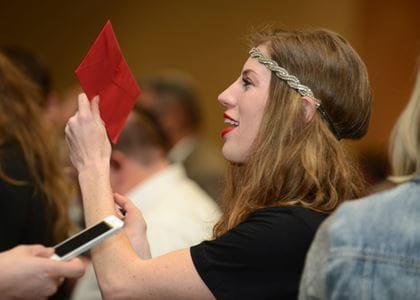INDIANAPOLIS — Indiana University School of Medicine students gathered March 20 to celebrate the end of four years of medical school and the beginning of the next phase of training. The 319 IU students, accompanied by family and friends, waited — as did medical students nationwide — for announcements made during Match Day — better known as “The Match” by generations of medical students.
The day is a sober one for the students who have invested years in the classroom. During their senior year, students apply and interview for their preferred residency positions throughout the nation; their selection is administered through the National Resident Matching Program of the Association of American Medical Colleges.
Not all students get their first or second choice, but IU School of Medicine has a history of favorable matches for students.
“The residency match is increasingly competitive and stressful, but IU students continue to do well,” said Sheryl E. Allen, M.D., M.S., associate dean for medical student affairs and associate professor of clinical emergency medicine and pediatrics. “We’re happy that a large number of our students will be staying at the IU medical center and in Indiana for their residencies, and we are also sending graduates to many other prestigious programs in the country, including Johns Hopkins, Mayo, Stanford and Baylor, to name just a few.”
As parents, spouses and friends anxiously awaited the news, 301 fourth-year IU medical students collected their sealed envelopes, shook hands with faculty and then, in unison, opened their envelopes.
Students in the IU School of Medicine Class of 2015, who will receive their medical degrees May 10, accepted residency positions in 34 states. Among the Match Day highlights:
• 34 percent of the students will pursue at least part of their residencies in Indiana.
• 77 students will be residents at IU Hospital, Riley Hospital for Children, other IU Health facilities, Eskenazi Health Services or the Roudebush VA Medical Center.
• 38 percent of IU School of Medicine graduates will enter primary-care programs, which include internal medicine, family medicine, pediatrics, obstetrics/gynecology, primary internal medicine and combined internal medicine-pediatrics.
The IU School of Medicine, the second largest medical school in the United States with more than 1,300 students, has nine medical education centers throughout the state. The programs are the IU Medical Sciences Program in Bloomington, IUSM-Evansville, IUSM-Fort Wayne, IUSM- Muncie, IUSM-Northwest, IUSM-South Bend, IUSM-Terre Haute, IUSM-West Lafayette and the main medical education campus at Indiana University-Purdue University Indianapolis.




